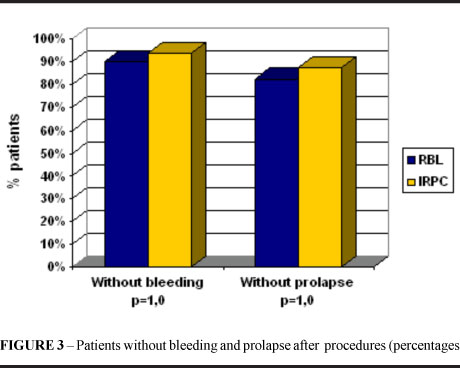PURPOSE: To compare the results of rubber band ligation and infrared photocoagulation for the treatment of hemorrhoidal disease through the analysis of the incidence of complications after each treatment and respective success rate. METHODS: Forty-eight patients with first, second or third degree hemorrhoidal disease were randomized to recieve treatment with either rubber band ligation (n=23) or infrared photocoagulation (n=25). Each patient was assessed at 1 week and 4 week intervals after treatment. We compared the incidence of complications and efficiency of each treatment modality and Qui-square, Fisher's Exact Test and Student's t Test were used to statistical analysis. RESULTS: Bleeding occured in eigth (34,7%) patients treated with rubber band ligation and in four (16,0%) after infrared photocoagulation (p=0,243). Thirteen (52,0%) patients felt pain during infrared photocoagulation and 9 (39,1%) after rubber band ligation (p=0,546). After rubber band ligation, 14 (60,8%) required medication for pain relief. One patient (4,0%) required medication after infrared photocoagulation (p<0,001). Three (13,0%) patients treated with rubber band ligator and 1 (4,0%) treated with infrared photocoagulation had symptomatic mucosal ulcers. Perianal dermatitis occured in two (8,0%) patients treated with infrared photocoagulation and one patient (4,3%) was observed to have prolapsed thrombosed piles after rubber band ligation. One month after treatment, 17 of 23 patients treated with rubber band ligation (73,9%) and 18 of 25 patients treated with infrared photocoagulation were asymptomatic. Rubber band ligation treated bleeding and prolapse in 90,0% and 82,4% respectively. Infrared photocoagulation treates bleeding and prolapse in 93,7% and 87,5% respectively. Those differences are not significant. CONCLUSION: Rubber band ligation causes significantly more pain than infrared photocoagulation during the first week after the procedures and their success rate are not different after four weeks of treatment.
Hemorrhoids; Ligation; Randomized controlled trials





